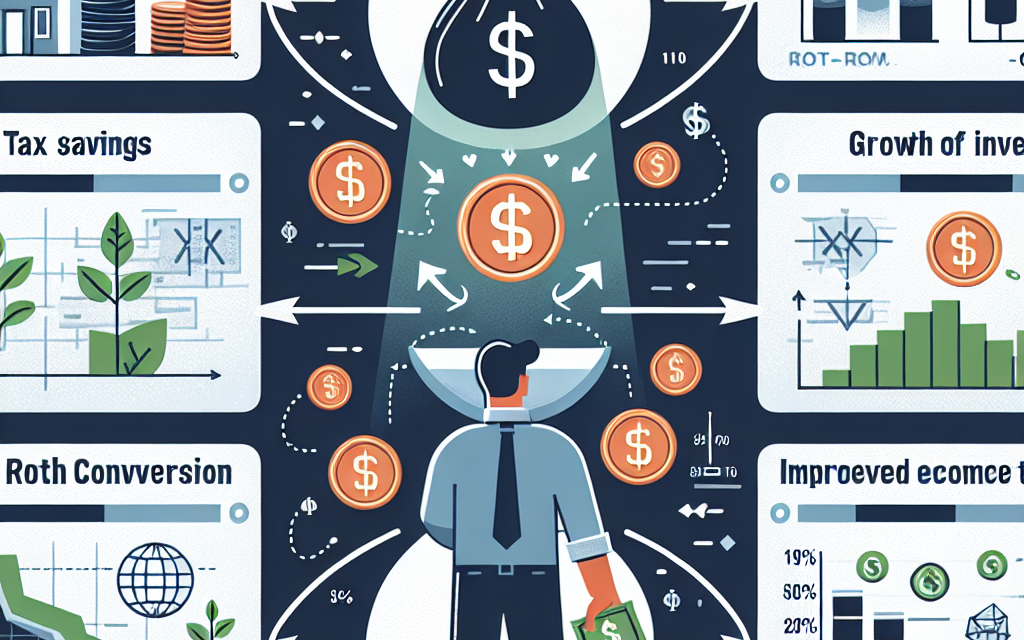“Unlock Your Future: Maximize Tax Efficiency with a Strategic 10% Roth Conversion Plan.”
Introduction
Maximizing tax efficiency is a crucial strategy for individuals seeking to optimize their retirement savings and minimize tax liabilities. A 10% Roth conversion plan offers a compelling approach to achieving these goals by allowing taxpayers to gradually convert a portion of their traditional retirement accounts into Roth IRAs. This method not only spreads the tax burden over several years, potentially keeping individuals in a lower tax bracket, but also provides the benefit of tax-free growth and withdrawals in retirement. By strategically implementing a 10% conversion plan, individuals can enhance their financial flexibility, reduce future tax obligations, and secure a more stable retirement income.
Understanding Roth Conversions
Roth conversions have gained significant attention in recent years as individuals seek to optimize their tax strategies for retirement. At its core, a Roth conversion involves transferring funds from a traditional retirement account, such as a 401(k) or traditional IRA, into a Roth IRA. This process allows individuals to pay taxes on the converted amount at their current income tax rate, rather than deferring taxes until retirement. Understanding the mechanics and benefits of Roth conversions is essential for anyone looking to maximize their tax efficiency.
One of the primary advantages of a Roth conversion is the potential for tax-free growth. Once funds are in a Roth IRA, they can grow tax-free, and qualified withdrawals during retirement are also tax-free. This feature is particularly appealing in a landscape where tax rates may increase in the future. By converting to a Roth IRA, individuals can lock in their current tax rate, which may be lower than the rates they could face later in life. This strategic move can lead to significant tax savings over time, especially for those who anticipate being in a higher tax bracket during retirement.
Moreover, a 10% Roth conversion plan can be an effective strategy for managing tax liabilities. This approach involves converting a fixed percentage of the total retirement account balance each year, allowing individuals to spread the tax burden over multiple years. By limiting the conversion amount to 10% annually, individuals can avoid pushing themselves into a higher tax bracket, which could result from a larger conversion. This gradual approach not only helps in managing tax implications but also provides the opportunity to adjust the conversion strategy based on changes in income or tax laws.
In addition to tax efficiency, Roth conversions can enhance estate planning strategies. Since Roth IRAs do not have required minimum distributions (RMDs) during the account holder’s lifetime, individuals can allow their investments to grow for a longer period. This feature is particularly beneficial for those who wish to leave a financial legacy for their heirs. By converting to a Roth IRA, individuals can pass on tax-free assets to their beneficiaries, providing them with a significant financial advantage. Furthermore, heirs who inherit a Roth IRA can withdraw funds tax-free, making it an attractive option for estate planning.
It is also important to consider the timing of a Roth conversion. Individuals may find it advantageous to convert during years of lower income, such as after retirement or during a sabbatical. By taking advantage of these lower income years, individuals can minimize the tax impact of the conversion. Additionally, market conditions can play a role; converting during a market downturn may allow individuals to pay taxes on a lower account balance, ultimately benefiting them when the market rebounds.
In conclusion, understanding Roth conversions and implementing a 10% conversion plan can significantly enhance tax efficiency and long-term financial planning. By taking advantage of tax-free growth, managing tax liabilities, and optimizing estate planning strategies, individuals can position themselves for a more secure financial future. As with any financial decision, it is advisable to consult with a tax professional or financial advisor to tailor a strategy that aligns with individual circumstances and goals. By doing so, individuals can navigate the complexities of retirement planning with confidence and clarity.
Benefits of a 10% Conversion Strategy
Maximizing tax efficiency is a crucial consideration for individuals planning for retirement, and one effective strategy that has gained traction is the 10% Roth conversion plan. This approach involves converting a portion of traditional retirement accounts, such as a 401(k) or traditional IRA, into a Roth IRA, specifically targeting a conversion amount that does not exceed 10% of the total account balance. The benefits of this strategy are multifaceted, offering both immediate and long-term advantages that can significantly enhance an individual’s financial landscape.
To begin with, one of the primary benefits of a 10% conversion strategy is the potential for tax diversification. By converting a portion of traditional retirement savings into a Roth IRA, individuals can create a mix of taxable and tax-free income sources for retirement. This diversification is particularly advantageous in managing tax liabilities during retirement years. As tax rates fluctuate, having both types of accounts allows retirees to strategically withdraw funds from the most tax-efficient source, thereby minimizing their overall tax burden.
Moreover, the 10% conversion plan can be particularly beneficial for those who anticipate being in a higher tax bracket in the future. By converting a portion of their traditional accounts now, individuals can lock in their current tax rate, which may be lower than future rates. This proactive approach not only mitigates the risk of higher taxes down the line but also allows for the potential growth of the converted funds in a tax-free environment. As the investments within a Roth IRA grow, the absence of taxes on qualified withdrawals can lead to substantial savings over time.
In addition to tax diversification and potential future tax savings, the 10% conversion strategy also offers flexibility in retirement planning. Roth IRAs do not have required minimum distributions (RMDs) during the account holder’s lifetime, unlike traditional IRAs. This feature allows individuals to retain control over their retirement funds for a longer period, enabling them to withdraw only when necessary. Consequently, this flexibility can be particularly advantageous for those who wish to leave a financial legacy for their heirs, as Roth IRAs can be passed on without the burden of immediate taxation.
Furthermore, implementing a 10% conversion strategy can also provide a buffer against market volatility. By gradually converting a portion of traditional accounts into a Roth IRA, individuals can take advantage of market dips, converting when asset values are lower. This approach not only maximizes the potential growth of the converted funds but also minimizes the tax impact of the conversion itself. As a result, individuals can optimize their investment strategy while simultaneously managing their tax liabilities.
Lastly, the psychological benefits of a 10% conversion plan should not be overlooked. Knowing that a portion of retirement savings is growing tax-free can provide peace of mind, allowing individuals to focus on their long-term financial goals without the constant worry of future tax implications. This sense of security can enhance overall financial well-being, enabling individuals to enjoy their retirement years with greater confidence.
In conclusion, the 10% Roth conversion plan presents a compelling strategy for maximizing tax efficiency in retirement planning. By fostering tax diversification, offering flexibility, and providing potential future tax savings, this approach can significantly enhance an individual’s financial outlook. As individuals navigate the complexities of retirement savings, considering a 10% conversion strategy may prove to be a prudent decision that yields substantial benefits over time.
Tax Implications of Roth Conversions
When considering the tax implications of Roth conversions, it is essential to understand how these financial strategies can significantly impact an individual’s overall tax efficiency. A Roth conversion involves transferring funds from a traditional retirement account, such as a 401(k) or traditional IRA, into a Roth IRA. This process is particularly advantageous because it allows individuals to pay taxes on their retirement savings at their current income tax rate rather than at potentially higher rates in the future. Consequently, implementing a 10% Roth conversion plan can be a strategic approach to managing tax liabilities over time.
To begin with, one of the primary benefits of a Roth conversion is the tax-free growth potential it offers. Once funds are transferred into a Roth IRA, they can grow without incurring any taxes, provided that certain conditions are met. This feature is particularly appealing for individuals who anticipate being in a higher tax bracket during retirement. By converting a portion of their traditional retirement accounts to a Roth IRA, individuals can lock in their current tax rate, thereby mitigating the risk of higher taxes on their withdrawals in the future.
Moreover, a 10% conversion plan allows for a gradual approach to managing tax implications. By converting only a portion of the total retirement savings each year, individuals can avoid pushing themselves into a higher tax bracket. This strategy not only helps in managing the immediate tax burden but also allows for better cash flow management. For instance, if an individual converts 10% of their traditional IRA each year, they can strategically plan for the tax payments associated with the conversion, ensuring that they do not face an overwhelming tax bill at once.
In addition to the immediate tax benefits, Roth conversions can also have long-term implications for estate planning. Since Roth IRAs do not have required minimum distributions (RMDs) during the account holder’s lifetime, individuals can allow their investments to grow tax-free for a more extended period. This feature can be particularly beneficial for those who wish to leave a financial legacy for their heirs. By converting to a Roth IRA, individuals can pass on tax-free assets to their beneficiaries, thereby enhancing their overall estate value.
Furthermore, it is important to consider the timing of Roth conversions. Market conditions and personal financial situations can significantly influence the effectiveness of a conversion strategy. For example, during years of lower income or market downturns, individuals may find it advantageous to convert a larger percentage of their traditional retirement accounts. This approach allows them to take advantage of lower tax rates and potentially maximize their tax efficiency.
In conclusion, the tax implications of Roth conversions are multifaceted and can provide significant benefits when approached strategically. A 10% Roth conversion plan not only facilitates tax-free growth and offers flexibility in managing tax liabilities but also enhances estate planning opportunities. By carefully considering the timing and amount of conversions, individuals can optimize their retirement savings while minimizing their tax burdens. Ultimately, understanding these implications is crucial for anyone looking to maximize their tax efficiency and secure a financially stable future.
Timing Your Roth Conversion
Timing your Roth conversion is a critical aspect of maximizing tax efficiency, particularly when considering the benefits of a 10% Roth conversion plan. The strategic timing of this financial maneuver can significantly influence the overall tax implications and long-term growth potential of your retirement savings. To begin with, understanding the nuances of your current tax situation is essential. By evaluating your income level, tax bracket, and potential changes in your financial circumstances, you can identify the most opportune moments to execute a Roth conversion.
One of the primary considerations in timing your Roth conversion is the fluctuation of income. For instance, if you anticipate a year with lower income—perhaps due to a sabbatical, job change, or other factors—this may present an ideal opportunity to convert a portion of your traditional IRA to a Roth IRA. By doing so during a lower income year, you can take advantage of a reduced tax rate, thereby minimizing the tax burden associated with the conversion. This approach not only allows you to convert a larger amount without pushing yourself into a higher tax bracket but also sets the stage for tax-free growth in the future.
Moreover, it is prudent to consider the broader economic environment when planning your Roth conversion. Market conditions can play a significant role in determining the timing of your conversion. For example, if the market experiences a downturn, the value of your investments may be lower, allowing you to convert a larger number of shares at a reduced tax cost. Consequently, when the market rebounds, the growth on those investments will occur in a tax-free environment, enhancing the overall benefits of your conversion strategy.
In addition to personal income and market conditions, legislative changes can also impact the timing of your Roth conversion. Tax laws are subject to change, and potential increases in tax rates could make it advantageous to convert sooner rather than later. By staying informed about proposed tax legislation and potential reforms, you can make proactive decisions regarding your Roth conversion strategy. This foresight can help you avoid higher tax liabilities in the future, ensuring that your retirement savings are optimized for tax efficiency.
Furthermore, it is essential to consider your long-term financial goals when timing your Roth conversion. If you plan to leave a financial legacy for your heirs, a Roth IRA can be particularly beneficial, as it allows for tax-free withdrawals and does not require minimum distributions during your lifetime. Therefore, aligning your conversion strategy with your estate planning objectives can enhance the overall effectiveness of your financial plan.
In conclusion, the timing of your Roth conversion is a multifaceted decision that requires careful consideration of various factors, including your current income, market conditions, legislative changes, and long-term financial goals. By adopting a strategic approach to timing your conversion, particularly through a 10% Roth conversion plan, you can maximize tax efficiency and set the stage for a more secure financial future. Ultimately, the key lies in being proactive and informed, allowing you to navigate the complexities of tax planning with confidence and clarity.
Long-Term Growth Potential of Roth Accounts
The long-term growth potential of Roth accounts is a compelling reason for individuals to consider a 10% Roth conversion plan as part of their overall tax strategy. Roth accounts, particularly Roth IRAs, offer unique advantages that can significantly enhance an individual’s financial future. One of the most notable benefits is the tax-free growth that these accounts provide. Unlike traditional retirement accounts, where taxes are deferred until withdrawal, Roth accounts allow for tax-free withdrawals in retirement, provided certain conditions are met. This feature can be particularly advantageous for those who anticipate being in a higher tax bracket in the future, as it allows them to lock in their current tax rate on contributions.
Moreover, the ability to withdraw contributions tax-free at any time adds a layer of flexibility that is often overlooked. This means that individuals can access their contributions without incurring penalties or taxes, making Roth accounts an attractive option for those who may need to tap into their savings before retirement. As a result, the long-term growth potential of Roth accounts is not only about the accumulation of wealth but also about the strategic access to funds when necessary.
In addition to tax-free growth and flexible access, Roth accounts are not subject to required minimum distributions (RMDs) during the account holder’s lifetime. This feature allows individuals to maintain their investments for a longer period, potentially leading to greater growth. By avoiding RMDs, account holders can let their investments compound over time, which can significantly enhance the overall value of their retirement savings. This aspect is particularly beneficial for those who do not need to rely on their retirement savings for living expenses, as it allows them to maximize the growth potential of their investments.
Furthermore, the 10% Roth conversion plan can serve as a strategic tool for managing tax liabilities over time. By converting a portion of traditional retirement accounts to Roth accounts gradually, individuals can spread out their tax burden, potentially keeping themselves in a lower tax bracket. This approach not only minimizes the immediate tax impact but also sets the stage for long-term tax-free growth. As the converted funds grow within the Roth account, they can accumulate without the drag of taxes, ultimately leading to a more substantial nest egg for retirement.
Additionally, the long-term growth potential of Roth accounts is enhanced by the ability to pass on tax-free wealth to heirs. Unlike traditional accounts, which may be subject to income tax upon withdrawal by beneficiaries, Roth accounts can provide a tax-free inheritance. This feature can be particularly appealing for individuals who wish to leave a financial legacy for their loved ones, as it allows them to maximize the value of their estate without the burden of tax implications.
In conclusion, the long-term growth potential of Roth accounts, combined with the strategic advantages of a 10% Roth conversion plan, presents a powerful opportunity for individuals seeking to enhance their financial future. By taking advantage of tax-free growth, flexible access to funds, and the ability to pass on wealth tax-free, individuals can position themselves for a more secure and prosperous retirement. As such, incorporating a Roth conversion strategy into one’s financial planning can yield significant benefits that extend well beyond the immediate tax implications, ultimately fostering a more robust financial legacy.
Common Mistakes in Roth Conversions
When considering a Roth conversion, individuals often focus on the potential benefits, such as tax-free growth and withdrawals in retirement. However, it is equally important to be aware of common mistakes that can undermine the effectiveness of a Roth conversion strategy. One prevalent error is failing to account for the tax implications of the conversion itself. When converting traditional IRA assets to a Roth IRA, the amount converted is added to the individual’s taxable income for that year. This can inadvertently push the taxpayer into a higher tax bracket, resulting in a larger tax bill than anticipated. Therefore, it is crucial to carefully calculate the potential tax impact before proceeding with a conversion.
Another mistake frequently made is not considering the timing of the conversion. Many individuals rush into a Roth conversion without evaluating their current and projected future income levels. For instance, if a person expects to be in a lower tax bracket in the coming years, it may be more advantageous to delay the conversion until that time. Conversely, if an individual is currently in a low-income year, such as during a gap in employment, this may present an ideal opportunity for a conversion at a lower tax rate. Thus, timing plays a significant role in maximizing the benefits of a Roth conversion.
Additionally, some individuals overlook the importance of understanding their overall financial situation, including their retirement goals and other sources of income. A common pitfall is converting too much too quickly, which can lead to a substantial tax burden. It is essential to develop a strategic plan that considers not only the immediate tax consequences but also the long-term implications for retirement income. By spreading conversions over several years, individuals can manage their tax liability more effectively and avoid the shock of a large tax bill.
Moreover, failing to account for the impact of state taxes can also be a significant oversight. While federal tax implications are often the primary focus, state taxes can add another layer of complexity to the conversion process. Different states have varying tax rates and rules regarding retirement accounts, which can affect the overall cost of a Roth conversion. Therefore, it is advisable to consult with a tax professional who understands both federal and state tax laws to ensure a comprehensive approach to the conversion strategy.
Another common mistake is neglecting to consider the impact of Medicare premiums. For individuals approaching retirement age, the income reported on tax returns can influence Medicare premiums. A significant increase in income due to a Roth conversion may result in higher premiums, which can erode some of the benefits gained from the conversion. Thus, it is vital to evaluate how a Roth conversion may affect not only current tax liabilities but also future healthcare costs.
Lastly, individuals often fail to revisit their conversion strategy periodically. Financial situations and tax laws can change, making it essential to reassess the effectiveness of a Roth conversion plan regularly. By staying informed and adaptable, individuals can make necessary adjustments to their strategy, ensuring that they continue to maximize tax efficiency throughout their retirement planning journey. In conclusion, avoiding these common mistakes can significantly enhance the effectiveness of a Roth conversion strategy, ultimately leading to greater financial security in retirement.
Case Studies: Successful 10% Roth Conversion Plans
In the realm of personal finance, the strategic management of tax liabilities is paramount, particularly as individuals approach retirement. One effective method that has gained traction is the implementation of a 10% Roth conversion plan. This approach allows individuals to convert a portion of their traditional retirement accounts into Roth IRAs, thereby optimizing their tax efficiency. To illustrate the benefits of this strategy, several case studies highlight the successful application of a 10% Roth conversion plan, showcasing its potential to enhance long-term financial outcomes.
Consider the case of a 55-year-old couple, John and Mary, who have accumulated significant assets in their traditional IRAs. With a combined annual income of $100,000, they found themselves in the 22% federal tax bracket. Recognizing the potential for tax increases in the future, they decided to implement a 10% Roth conversion plan. By converting 10% of their traditional IRA balance each year, they effectively managed their taxable income, ensuring that they remained within their current tax bracket. This strategy not only allowed them to pay taxes at a lower rate but also enabled their converted funds to grow tax-free in the Roth IRA. As a result, by the time they reached retirement at age 65, they had significantly increased their tax-free income, providing them with greater financial flexibility.
Another compelling example is that of Sarah, a single professional in her early 60s. With a traditional IRA balance of $500,000 and a steady income of $80,000, Sarah was concerned about the impact of required minimum distributions (RMDs) on her tax situation once she reached age 72. To mitigate this concern, she opted for a 10% Roth conversion plan, converting $50,000 annually. This approach not only reduced her traditional IRA balance, thereby lowering her future RMDs, but also allowed her to take advantage of her current lower tax bracket. By the time she reached retirement, Sarah had successfully transitioned a substantial portion of her retirement savings into a tax-free environment, ensuring that her tax burden would be minimized in her later years.
Furthermore, the case of Tom and Lisa, a couple in their late 50s, illustrates the long-term benefits of a 10% Roth conversion plan in the context of estate planning. With a combined retirement account balance of $1 million, they were keen on leaving a tax-efficient legacy for their children. By converting 10% of their traditional IRAs each year, they not only reduced their taxable income but also positioned their heirs to inherit tax-free assets. This strategic move allowed Tom and Lisa to maximize the value of their estate while minimizing the tax implications for their beneficiaries. As they approached retirement, they felt confident that their financial decisions would have a lasting positive impact on their family’s future.
In conclusion, the case studies of John and Mary, Sarah, and Tom and Lisa exemplify the myriad benefits of a 10% Roth conversion plan. By strategically converting a portion of their traditional retirement accounts, these individuals effectively managed their tax liabilities, enhanced their financial flexibility, and secured a more favorable tax environment for their heirs. As the landscape of tax legislation continues to evolve, the importance of proactive tax planning cannot be overstated. A 10% Roth conversion plan stands out as a viable strategy for individuals seeking to maximize their tax efficiency and achieve their long-term financial goals.
Q&A
1. **What is a 10% Roth Conversion Plan?**
A 10% Roth Conversion Plan involves converting 10% of your traditional retirement account assets to a Roth IRA each year to minimize tax impact.
2. **What are the tax benefits of a Roth conversion?**
Roth conversions allow for tax-free growth and tax-free withdrawals in retirement, as long as certain conditions are met.
3. **How does a 10% conversion help with tax brackets?**
By converting only 10% of your assets annually, you can manage your taxable income and potentially avoid moving into a higher tax bracket.
4. **What is the impact on required minimum distributions (RMDs)?**
Converting to a Roth IRA reduces the amount subject to RMDs, as Roth IRAs do not have RMDs during the account holder’s lifetime.
5. **Can a 10% conversion plan be adjusted based on income changes?**
Yes, the conversion amount can be adjusted each year based on changes in income, tax rates, and financial goals.
6. **What are the potential downsides of a Roth conversion?**
The main downside is the immediate tax liability incurred from the conversion, which can affect cash flow and overall tax situation in the year of conversion.
7. **Who should consider a 10% Roth Conversion Plan?**
Individuals expecting to be in a higher tax bracket in retirement, those with significant traditional retirement assets, or those seeking tax diversification should consider this strategy.
Conclusion
A 10% Roth conversion plan can significantly enhance tax efficiency by allowing individuals to strategically manage their taxable income over time. By converting a portion of traditional retirement accounts to Roth accounts at a controlled rate, taxpayers can minimize their tax burden during retirement, avoid higher tax brackets, and benefit from tax-free growth and withdrawals. This approach not only provides flexibility in retirement income planning but also helps in estate planning by reducing the tax impact on heirs. Overall, a 10% Roth conversion plan serves as a valuable strategy for optimizing tax outcomes and securing long-term financial health.





